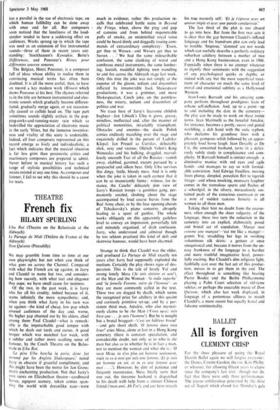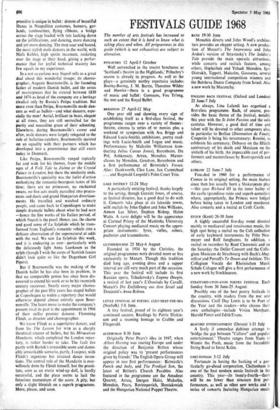All is forgiven
BALLET CLEMENT CRISP
For the sheer pleasure of seeing the Royal Danish Ballet again we will forgive everyone: the Danes, Covent Garden, the CIA. Kim Philby. or whoever, for allowing fifteen years to elapse since the company's last visit—though not thc fact that there were only three performances The joyous exhilaration generated by the third act of Napoli which closed last Monday's gala premibre is unique in ballet: dozens of beautiful Danes in Neapolitan costumes, banners, gar- lands, tambourines, Hying ribbons, a bridge across the stage loaded with tots looking down on the jollifications, and dancing, more dancing and yet more dancing. The men soar and bound, Use most stylish male dancers in the world, with Niels Kehlet, high spirits incarnate, rocketing over the stage at their head, giving a perfor- mance that for joyful technical mastery has few equals in my experience.
In a not so curious way Napoli tells us a great deal about this wonderful troupe; its choreo- grapher, Auguste Bournonville, is the founding father of modern Danish ballet, and the series of masterpieces that he created between 1830 and 1876 as head of the company are a heritage rivalled only by Russia's Petipa tradition. But More even than Petipa, Bournonville made dan- cers as well as ballets—and what dancers, espe- cially the men! Aerial, brilliant in beats, elegant at all times, they are still unrivalled for the purity and masculine grace of their schooling. Elsewhere, during Bournonville's career and after, male dancers were largely relegated to the role of ballerina-catchers; Bournonville insisted on an equality with their partners which has developed into a preeminence that still exists today in Denmark.
Like Petipa, Bournonville ranged topically far and wide for his themes, from the middle ages of A Folk Tale to Zulma or the Crystal Palace in London, but there the similarity ends. Bournonville's speciality was the ballet d'action embodying the romantic-bourgeois tastes of his time; there are no princesses, no enchanted swans, no five acts neatly parcelled into proces- sions and duets and grand Hungarian divertisse- ments. He travelled and watched ordinary people, and came back to Copenhagen to make simple dramatic ballets about what he had seen —hence the fine works of his Italian period, of which Napoli is the pearl. Hence, too, the charm and good sense of' La Sylphide which he trans- formed from Taglioni's romantic vehicle into a delicate observation of the supernatural at odds with the real. We saw La Sylphide this week, and it is endearing as ever—particularly with the deliciously light Anna Laerkesen as the sylph (though I wish the corps of Scottish lassies didn't look quite so like the Dagenham Girl Pipers).
But if Bournonville was the making of the Danish ballet he has also been its problem, in that no comparable genius has since been dis- covered to extend his work or to be his twentieth century successor. Nearly every major choreo- grapher of the past fifty years has staged ballets in Copenhagen to widen a repertory that would otherwise depend almost entirely upon Bour- nonville. The latest move to make the company's present rival its past is the appointment in 1%6 of their stellar premier danseur, Flemming Flindt, as director and choreographer.
We know Flindt as a superlative dancer, and from his The Lesson for VVTES as a sharply theatrical creator of ballets, but his Miraculous Mandarin, which completed the London reper- tory, is rather harder to take. The fault lies partly with Bartok's irresistible score and damn- ably unworkable scenario, partly, I suspect, with Flindt's ingenious but strained dance inven- tions. The central role of the Mandarin is mar- vellously done by FTuidt himself, but the prosti- tute, seen as an erotic wind-up doll, is hardly successful, and the piece seem to lack the ferocious momentum of the score. A pity, but only a slight blemish on a superb programme. More, please, and soon.







































 Previous page
Previous page